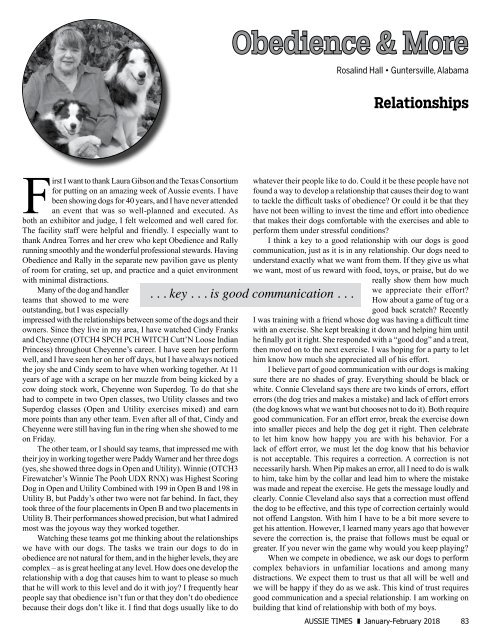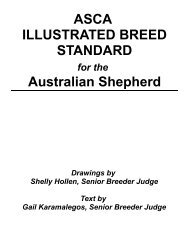You also want an ePaper? Increase the reach of your titles
YUMPU automatically turns print PDFs into web optimized ePapers that Google loves.
Obedience & More<br />
Rosalind Hall • Guntersville, Alabama<br />
Relationships<br />
First I want to thank Laura Gibson and the Texas Consortium<br />
for putting on an amazing week of Aussie events. I have<br />
been showing dogs for 40 years, and I have never attended<br />
an event that was so well-planned and executed. As<br />
both an exhibitor and judge, I felt welcomed and well cared for.<br />
The facility staff were helpful and friendly. I especially want to<br />
thank Andrea Torres and her crew who kept Obedience and Rally<br />
running smoothly and the wonderful professional stewards. Having<br />
Obedience and Rally in the separate new pavilion gave us plenty<br />
of room for crating, set up, and practice and a quiet environment<br />
with minimal distractions.<br />
Many of the dog and handler<br />
teams that showed to me were<br />
outstanding, but I was especially<br />
impressed with the relationships between some of the dogs and their<br />
owners. Since they live in my area, I have watched Cindy Franks<br />
and Cheyenne (OTCH4 SPCH PCH WITCH Cutt’N Loose Indian<br />
Princess) throughout Cheyenne’s career. I have seen her perform<br />
well, and I have seen her on her off days, but I have always noticed<br />
the joy she and Cindy seem to have when working together. At 11<br />
years of age with a scrape on her muzzle from being kicked by a<br />
cow doing stock work, Cheyenne won Superdog. To do that she<br />
had to compete in two Open classes, two Utility classes and two<br />
Superdog classes (Open and Utility exercises mixed) and earn<br />
more points than any other team. Even after all of that, Cindy and<br />
Cheyenne were still having fun in the ring when she showed to me<br />
on Friday.<br />
The other team, or I should say teams, that impressed me with<br />
their joy in working together were Paddy Warner and her three dogs<br />
(yes, she showed three dogs in Open and Utility). Winnie (OTCH3<br />
Firewatcher’s Winnie The Pooh UDX RNX) was Highest Scoring<br />
Dog in Open and Utility Combined with 199 in Open B and 198 in<br />
Utility B, but Paddy’s other two were not far behind. In fact, they<br />
took three of the four placements in Open B and two placements in<br />
Utility B. Their performances showed precision, but what I admired<br />
most was the joyous way they worked together.<br />
Watching these teams got me thinking about the relationships<br />
we have with our dogs. The tasks we train our dogs to do in<br />
obedience are not natural for them, and in the higher levels, they are<br />
complex – as is great heeling at any level. How does one develop the<br />
relationship with a dog that causes him to want to please so much<br />
that he will work to this level and do it with joy? I frequently hear<br />
people say that obedience isn’t fun or that they don’t do obedience<br />
because their dogs don’t like it. I find that dogs usually like to do<br />
whatever their people like to do. Could it be these people have not<br />
found a way to develop a relationship that causes their dog to want<br />
to tackle the difficult tasks of obedience? Or could it be that they<br />
have not been willing to invest the time and effort into obedience<br />
that makes their dogs comfortable with the exercises and able to<br />
perform them under stressful conditions?<br />
I think a key to a good relationship with our dogs is good<br />
communication, just as it is in any relationship. Our dogs need to<br />
understand exactly what we want from them. If they give us what<br />
we want, most of us reward with food, toys, or praise, but do we<br />
really show them how much<br />
we appreciate their effort?<br />
How about a game of tug or a<br />
good back scratch? Recently<br />
I was training with a friend whose dog was having a difficult time<br />
with an exercise. She kept breaking it down and helping him until<br />
he finally got it right. She responded with a “good dog” and a treat,<br />
then moved on to the next exercise. I was hoping for a party to let<br />
him know how much she appreciated all of his effort.<br />
I believe part of good communication with our dogs is making<br />
sure there are no shades of gray. Everything should be black or<br />
white. Connie Cleveland says there are two kinds of errors, effort<br />
errors (the dog tries and makes a mistake) and lack of effort errors<br />
(the dog knows what we want but chooses not to do it). Both require<br />
good communication. For an effort error, break the exercise down<br />
into smaller pieces and help the dog get it right. Then celebrate<br />
to let him know how happy you are with his behavior. For a<br />
lack of effort error, we must let the dog know that his behavior<br />
is not acceptable. This requires a correction. A correction is not<br />
necessarily harsh. When Pip makes an error, all I need to do is walk<br />
to him, take him by the collar and lead him to where the mistake<br />
was made and repeat the exercise. He gets the message loudly and<br />
clearly. Connie Cleveland also says that a correction must offend<br />
the dog to be effective, and this type of correction certainly would<br />
not offend Langston. With him I have to be a bit more severe to<br />
get his attention. However, I learned many years ago that however<br />
severe the correction is, the praise that follows must be equal or<br />
greater. If you never win the game why would you keep playing?<br />
When we compete in obedience, we ask our dogs to perform<br />
complex behaviors in unfamiliar locations and among many<br />
distractions. We expect them to trust us that all will be well and<br />
we will be happy if they do as we ask. This kind of trust requires<br />
good communication and a special relationship. I am working on<br />
building that kind of relationship with both of my boys.<br />
. . . key . . . is good communication . . .<br />
AUSSIE TIMES January-February <strong>2018</strong> 83



